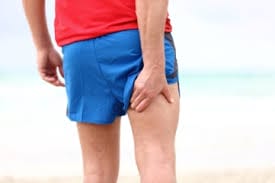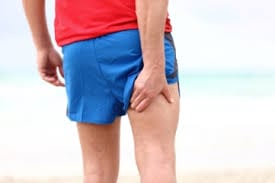
- Almost halves recovery time
- Reduces re-injury by over 90%
- And get you pain-free faster!
Just by doing the right rehab exercises at home!
Fortunately there has been some good research done on hamstring rehab in the last few years and one in particular in 2013 by Askling et al compared the effectiveness of two rehab protocols:
– The “C” protocol, which are the conventional rehab exercises
– The “L protocol” which is the eccentric Lengthening exercises
They found in this study that rehabilitating a hamstring strain using specific eccentric exercises has a significant improvement in healing time and there were no re-injuries in the year following by following the L-protocol and return to play guidelines.
This means:
- Return to sport on average after 28 days vs 51 days for conventional exercises
- Nearly 0% re-injury rate vs the usual 12%
- Weeks off your recovery, not to mention the weeks if injured again.
So what are eccentric exercises?
Usually when exercising you may think about form, reps, sets and balancing out your routine but not always about what kind of muscle contraction you are doing. And fair enough too, so here is the difference between concentric and eccentric muscle contraction:
Concentric: This is shortening of the muscle, where all the muscle fibers are drawing together. This is what most people would think of as a muscle contraction, eg a biceps curl.
Eccentric contraction: This is controlled lengthening of the muscle – putting the brakes on. So the muscle has to work to control the muscle lengthening out – like lowering the weight back down after the biceps curl. This type of contraction actually creates a lot more force and acts and when used in rehabilitation acts to re-align the muscle or tendon fibers along the correct line of pull.
Hamstrings are most often injured during when slowing down your foot/leg swinging forward (putting the brakes on it before your heel touches down). During this action, your hamstrings are working eccentrically. So wouldn’t rehabilitating the muscle eccentrically be best to address the hamstring strain and the obvious weakness that was there? Yes!
So, let’s get to the rehab, to get you recovering faster and stronger with less re-injury:
*Before you start the L protocol: In the first 48-72 hours directly after an injury you should RICE it – see this post for more details
The L-protocol:
Note: The “L” stands for lengthening.
The following three exercises should be started 2-3 days after injury – Below they are demonstrated in videos (they may take a short time to load but, it is worth it to do the exercises right!) and photos as guidance courtesy of the BJSM website.
1. The Extender:

2. Diver

3. Glider:

Reps, sets and timing:
- Extender: Two times daily, every day, 3 sets x 12 repetitions
- Diver: Once every second day, 3 sets x 6 repetitions
- Glider: Once every third day, 3 sets x 4 repetitions
How do you know if you are ready to return to sport?
When these two tests are negative then you can return to play:
Place your heel on a chair with knee bent as shown with your un-injured leg straight in the air. Pushing through your heel lift your bottom off the ground.
Compare to the other side
Negative test: Pain-free and equal on both sides.

Lying on your back , lift your injured leg up as fast as you can through full range.
Negative test: No pain OR apprehension. If there is apprehension, the rehab exercises need to be done for a further 3-5 days and re-tested.
So, if you have a hamstring strain – Get started on your rehab now, and get back to what you love faster. This isn’t just showed to work in the research, I have prescribed this protocol to my own patients, including football players and international level sprinters, and it does work.
Stay tuned for my next post on preventing hamstring strains – Because prevention is the best cure!
Please Share, like, follow and let me know how you get on!



should you start the L protocol if your hamstring still hurts after 72 hours?
Hi James
It is important not to push into pain – exercise within the comfortable (relatively) range. The extender, at least should be doable within a partial range.
Hi Toni
If you have strained your hamstring then yes a break from loading up this muscle while rehabbing can definately help and then build back in as able.
For the glider exercise, is our hurt leg extending backwards? Or are we extending backwards with our healthy leg while keeping me the injured one forward?
Hi Tim
For the Glider, our injured leg is at the front controlling our body sliding backwards and lengthening out.
Seems like great advice. Many thanks 🙂
Great advice. But the videos are not loading after 15 minutes. Any suggestions?
Thanks
Sorted thanks Neil, the videos should be up and running again
Thanks for fixing the videos. Much appreciated.
Pingback: Sports Injury: Hamstring Strain | Spinal Rehab & Sports Medicine
This may not get answered but for the diver is our hurt leg planted or the one bent in the air?
The injured leg is the planted leg Matt. Thanks